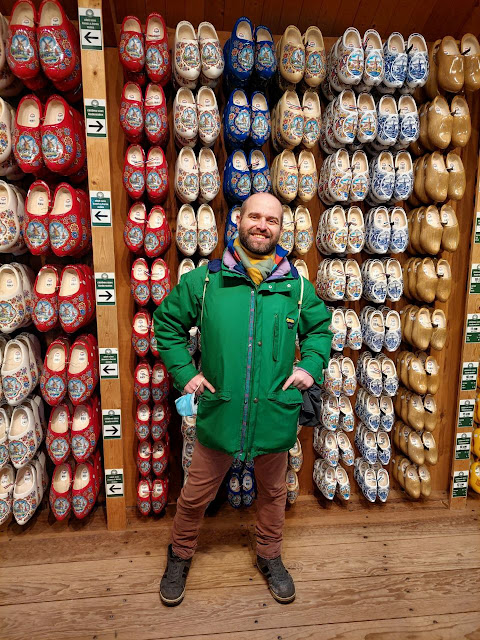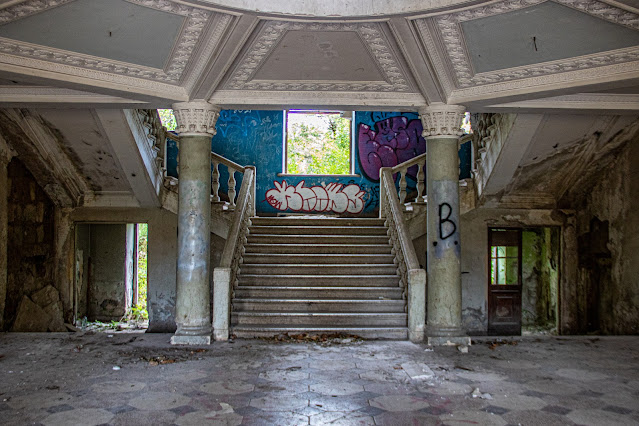Hiroshima
In autumn 2019 I travelled for one month in Japan, I
volunteered for two weeks in Minamata, in Kyushu Island, the other two weeks I visited some cities like
Tokyo and
Kyoto.
Hiroshima was the second city I visited on my Japan tour, I passed here only one day and it was a mistake: Hiroshima it's really beautiful with a lot to offer; now I think that I should have rescheduled my plans and given more time to this city.
I had the time only to visit the Memorial Park, with the Peace Memorial Museum, a bit around of it and the Miyajima island.
Peace Memorial Park
Memorial Park
This park became the centre of the rebirth of the city, it's a place where you can feel peace and at the same time commemorate, learn, don't forget what happened on August 6th 1945.
The location of the Peace Memorial Park was once the city's busiest downtown commercial and residential district, the park was built on an open field that was created by the explosion. The park now has memorials, monuments, museums and lecture halls.
We will never forget
Just on the other side of the river, concerning the Peace Memorial Park, there is the A-bomb dome, the only building that didn't surrender to the explosion. It became the symbol of what it was and what it will be for Hiroshima. It is the building closest to the hypocenter of the nuclear bomb that remained at least partially standing. It was attributed to it a sense of sacredness and transcendence, it is situated in a distant ceremonial view that is visible from the Peace Memorial Park.
The dome
The A-bomb dome, a UNESCO Heritage, was an industrial promotion hall before, and after the explosion, there was a debate on what to do whit it: keep it and protect it as a symbol, or destroy it to don't face every day that memory?. It was left as it was in memory of the casualties, it is officially designated site of memory for the nation's and humanity's collectively shared heritage of catastrophe.
Peace Museum
The Hiroshima Peace Memorial Museum is the primary museum in the park dedicated to educating visitors about the bomb. In the museum, exhibits and information are covering the war, the role of Hiroshima in the war up to the bombing, and extensive information on the bombing and its effects.
I went to visit it, I had to, I knew it could have been hard but I wanted to go, and it was difficult to arrive at the end of it, it is really emotional and cruel on showing what it was for the city and the citizens that period. I have to say that it's really well done, and I suggest visiting it, the visitors can face how it was during, and just after the bomb, and how it was for the survivors the following years.
Downtown
Night market
Takanbashi shopping street is a market near Takanobashi station, I was looking for a place for dinner and I randomly went around the city centre, and I found this huge cover night market. As a European, I'm not used to these places, and I really liked it, lights, people, energy, a lot of life!. By the way, I didn't eat there, there there are mainly shops, but just outside it, I was spoiled for choice.
Blinding lights
Hiroshima was founded in 1598 in the Ota River delta, from 1868 the city rapidly transformed into a major urban and industrial city. Since the rebuilding after the war, Hiroshima has become the largest city in the region with around 1.2 million inhabitants.
Unfortunately, Hiroshima is known, at least in Europe, only for the A-bomb, but it's very vibrant and dynamic, comparable to the other main cities in Japan.
Miyajima
Paradise
Itsukushima, popularly known as Miyajima, "Shrine Island" in Japanese, it's a big island in front of Hiroshima, very touristic, very beautiful, a paradise. Here you can find a lot of temples and shrines, as the name says, green hills with forests and a hiking route for the top of the island.
I reached the Island with public transportations, from Miyajimaguchi I took a JR ferry to the island, the trip takes around 10 minutes. That day I had a bus to Osaka in the afternoon, and I passed the morning and the early afternoon on the island.
God's messengers
The Island is home to more than a thousand Sika deer that are free to move, they are considered god's messengers and until 1637 killing one of these was punishable by death. Today they are protected by law and they are quite bold, always looking for food from the tourists, for these there are several signs and messages from the speakers to not tease, touch or feed the deers.
School trip
That morning on the island there was a lot of students on a school trip, I'm always fascinated by how Japanese students are tidy, wearing uniforms, or in case of school trips wearing the same hat with a colour code in a base of which grade they are.
The Market
Between the harbour and the Itsukushima shrine, there is a market that is mainly for tourists because there are souvenir shops and street food (oysters in all possible ways). I like these places because they are colourful and with a lot of people, and it is nice to see how different markets are in a base of different cultures around the world, here you can see the other side of the coin: Japanese are tidy, timid and really respectful on a side, and on the other, in these bazaars, you can see them shouting to catch your attention like in an Italian market.
Kimonos
When I saw this "couple" near the Itsukushima shrine I couldn't resist. It was a family shooting with a photographer, probably for a special occasion, Japanese friends told me that it's rare to wear the kimono when you are a kid: it needs to be an anniversary or something similar, and also it's a parents decision. To steal this picture was not easy, finding a nice perspective without being seen by the photographer and the parents was quite difficult.
Itsukushima shrine
It is a UNESCO World Heritage site and one of the National treasures, it was established in the time of Empress Suiko in 593. It is a Shinto Shrine, and one of the most famous in Japan because when there is high tide it's "floating" in the water. It is also surrounded by hills, so the atmosphere is magical: on a side the sea and on the other the green hills.
The hidden Torii
The main attraction in Miyajima island is the "floating" torii, which, unfortunately, was in renovation. As the Itsukushima shrine, also the torii, when there is high tide, is "floating" on the water, which makes it the most famous torii in Japan. Retaining the purity of the shrine is important, since 1878 no deaths or births have been permitted near it. To allow pilgrims to approach the shrine was built like a pier over the water, separate from the land, as the torii.
Toyokuni Shrine, Pagoda
Pagodas, in Japanese tō, were originally used as reliquaries, now are quintessentially Buddhist and an important component of Japanese Buddhist temple compounds, but they are less common on the shrines, and this is one of the exceptions. It was constructed in 1407.

Prospective
Senjokako is the largest structure in Miyajima as the name implies ("pavilion of 1000 mats"), it was built as a Buddhist library, during the Meiji reformation the structure was converted into a Shrine dedicated to the ideator Toyotomi Hideyoshi (Toyokuni Shrine).
I went inside the Toyokuni shrine, which is on the top of one of the hills of the island, and next to the pagoda. I enjoyed a lot this shrine, it relaxed me, a very peaceful place.
I appreciate a lot of different perspectives that you can have from inside the shrine, like this one in the picture.
The view
From a side of the shrine, opposite compared to the pictures before and after, there's this view of the beach near the harbour. Nature in Japan surprised me every day, there are no limits to the wonderful to discover. Before Toyotomi Hideyoshi, two Buddhist saints and Amitabha Buddha were enshrined in the structure.
Equilibrium
This is another view, another window to the world from the shrine. In this picture, I think some points inspire me to equilibrium: the man is in equilibrium, and I want to think he found his equilibrium praying, there's equilibrium between inside and outside: there is peace in both the parts and equilibrium between light and dark.
After this, I had lunch in a ramen restaurant, ramen is definitely my favourite Japanese food, always delicious and fulfilling. After lunch, I took the ferry back to Hiroshima, get back my backpack from the hostel and went to the bus station, I used mainly busses on my trip because they are cheaper than trains and really comfortable, the next stop was Osaka, another city another blog post
here.




















Thank you for sharing about Hiroshima. I enjoyed reading the story with lots of nice pictures. ♥️
ReplyDeleteThis post is a reminder of how beautiful nature is. The trees in Japan alone are exquisite.
ReplyDeleteThank you! Yes I totally agree with you!
DeleteV nice pictures, Rest of the world has to learn from Japan How to overcome from any disasters?
ReplyDeleteThank you!! Actually Japan don't have a commemoration day about the A-bomb, the August 6th is remembered only in Hiroshima. Another example of city that rise up from its ashes is Warsaw.
DeleteGreat post with such wonderful commentary and photos! I loved the photo with the children! Thanks for sharing.
ReplyDeleteGreat information and photos always wanted to visit Japan.
ReplyDeletehttps://www.wattophotos.co.uk
These are great photos and allow me to go where I probably never will
ReplyDeleteThank you!! And who knows what there will be in our future!
DeleteExcellent photos !!
ReplyDeleteBeautiful pictures! We hope we'll be able to visit Japan somedays :)
ReplyDeleteSo intresting, and great pictures!
ReplyDeleteBeautiful pictures! It is amazing how resilient people can be. Hiroshima is a wonderful reminder of that. Thanks for sharing!
ReplyDeleteI enjoyed seeing your photos & I would love to visit Japan one day because there is so much to see like Hiroshima and the shrines and temples.
ReplyDeleteThank you! you're right, Japan has a lot to offer, big cities, countryside, nature and history.
Delete